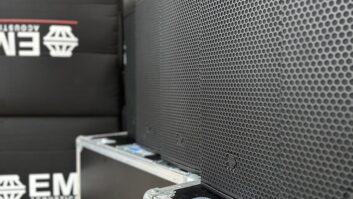 There’s no question that the higher education world has gone through significant changes over the past few years. From advancements in technology to evolving societal needs, colleges and universities have had to continuously reassess their approach to teaching.
There’s no question that the higher education world has gone through significant changes over the past few years. From advancements in technology to evolving societal needs, colleges and universities have had to continuously reassess their approach to teaching.
With that in mind, one of the most notable changes impacting higher education is the shift to hybrid and remote learning. This transition has brought on many new challenges that only technology can solve – with audio being at the centre of it all. As students and faculty continue to navigate the hybrid world, high-quality audio technology will play an important role in delivering effective communication, collaboration, and overall positive learning experiences.
REMOTE SHIFT
The shift to remote and hybrid learning, accelerated by the pandemic, underscored the importance of audio quality for both students and teachers. When the sound is poor in an educational environment, lessons are at risk of being unengaging, disrupted, or unheard altogether. It doesn’t matter if the best video solution is installed, or the best virtual communication platform is integrated if audio isn’t crystal clear.
Campuses should (and must!) evaluate their audio technology – from wireless microphones to speaker systems to training room controls – to ensure it meets the needs of in-person, hybrid and fully remote students and faculty. Good audio solutions should not only facilitate clear communication but also be easy to install and use all day, offer various lesson modes, seamlessly integrate with existing collaboration tools and support lecture capture systems for classes to be recorded and replayed at a later stage. Considering these factors will help guide decisions on investing in high-quality audio to address the current challenges of hybrid formats in higher education.
PREMIUM AUDIO
With premium audio technology, higher education institutions can significantly enhance academic success for both students and faculty. For students, clear audio is the foundation for active listening and comprehension, minimising communication challenges that might otherwise interfere with learning. Without the frustrations of poor audio quality, students can better focus and remain engaged throughout entire lessons, but also after the class, as with the right audio, lessons and lectures can be recorded and stored for replay in Learning Management Systems. Simultaneously, educators can confidently deliver their curricula knowing that their lessons are being effectively conveyed and recorded no matter where and when their students are tuning in from.
In highly collaborative learning environments, clear audio also helps facilitate effective teamwork, project discussions, and idea sharing while minimising technical difficulties, making group classes more productive overall. Meanwhile, superior audio technology helps higher education institutions establish credibility through a more professional appearance and the commitment to demonstrating excellence. Having a solid audio setup increases student satisfaction and retention, positively impacting learning outcomes and providing higher quality teaching and learning experiences.
POWER TOOLS
Additionally, advanced AV tools further empower students to receive an equitable and inclusive education regardless of their learning environment. Cutting-edge features such as noise-cancelling capabilities and adaptive audio algorithms enable clear communication even in noisy surroundings, bridging the gap between remote and in-person learners and ensuring access to an equally enriching educational experience for all.
Shure offers a wide range of conferencing solutions ideal for classrooms and education institutions that are easy to use and adopt by faculty. The recently launched Microflex Wireless (MXW) neXt 2, a two-channel wireless microphone system, is a perfect example of how versatility and innovation can ensure successful hybrid classes and lectures in a user-friendly manner.
LOOKING AHEAD
The future of technology in higher education will be built on the foundation of superior audio solutions. As interoperability becomes the standard for unified communication and collaboration tools, institutions should invest in audio technology that can be easily integrated, certified and used across diverse platforms and devices – ensuring it’s adaptable as technology and educational needs evolve.
In the coming years, institutions will be able to tap into emerging technologies such as spatial audio, AI-driven enhancements, and even virtual reality, offering immersive and personalised learning experiences catering to the diverse needs and preferences in higher education.
Ultimately, as the landscape continues to evolve, the power of high-quality audio in elevating higher education cannot be overstated. With superior audio solutions as the foundation for the path forward, higher education institutions can overcome the challenges of hybrid learning environments and improve the educational experience for students and faculty alike.







